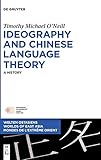Ideography and Chinese Language Theory : A History / Timothy Michael O’Neill.
Material type: TextSeries: Welten Ostasiens / Worlds of East Asia / Mondes de l’Extrême Orient : Im Auftrag der Schweizerischen Asiengesellschaft - On behalf of the Swiss Asia Society - Au nom de la Société Suisse-Asie ; 26Publisher: Berlin ; Boston : De Gruyter, [2016]Copyright date: ©2016Description: 1 online resource (VII, 348 p.)Content type:
TextSeries: Welten Ostasiens / Worlds of East Asia / Mondes de l’Extrême Orient : Im Auftrag der Schweizerischen Asiengesellschaft - On behalf of the Swiss Asia Society - Au nom de la Société Suisse-Asie ; 26Publisher: Berlin ; Boston : De Gruyter, [2016]Copyright date: ©2016Description: 1 online resource (VII, 348 p.)Content type: - 9783110457148
- 9783110457223
- 9783110459234
- 490 23
- online - DeGruyter
- Issued also in print.
| Item type | Current library | Call number | URL | Status | Notes | Barcode | |
|---|---|---|---|---|---|---|---|
 eBook
eBook
|
Biblioteca "Angelicum" Pont. Univ. S.Tommaso d'Aquino Nuvola online | online - DeGruyter (Browse shelf(Opens below)) | Online access | Not for loan (Accesso limitato) | Accesso per gli utenti autorizzati / Access for authorized users | (dgr)9783110459234 |
Frontmatter -- Table of Contents -- Acknowledgements -- Introduction: Egyptian Hieroglyphic and Chinese Characters -- Chapter One: Platonism and the Strong Theory -- Chapter Two: Aristotelianism and Soft Theory -- Chapter Three: Hellenized Egypt, Pythagoreanism, and the Primitivist Theory -- Chapter Four: Patristic Apologetics and the Scriptural Theory -- Chapter Five: Neoplatonism and the Hermetic Theory -- Chapter Six: Universals and the Scholastic Theory -- Chapter Seven: Renaissance Neoplatonism and the Emblematic Theory -- Chapter Eight: Athanasius Kircher on Egyptian and Chinese Ideography -- Chapter Nine: The Great Chinese Encyclopedia -- Chapter Ten: Zhengming 正名“Making Words Correct” and Chinese Language Theory -- Chapter Eleven: Chinese Language Theory and the Interpretation of the Classics -- Chapter Twelve: The Erya and Lexicographic Classification -- Chapter Thirteen: The Erya and Chinese Language Theory -- Chapter Fourteen: The Shuowen jiezi and Chinese Language Theory -- Chapter Fifteen: The “Shuowen Postface” (Annotated Translation) -- Conclusion: Ideography and Chinese Language Theory -- Appendix: The Metalinguistic Terms Ming 名,Yi 義,Yi 意, and Zhi 志 -- Bibliography
restricted access online access with authorization star
http://purl.org/coar/access_right/c_16ec
This book is a much-needed scholarly intervention and postcolonial corrective that examines why and when and how misunderstandings of Chinese writing came about and showcases the long history of Chinese theories of language. 'Ideography' as such assumes extra-linguistic, trans-historical, universal 'ideas' which are an outgrowth of Platonism and thus unique to European history. Classical Chinese discourse assumes that language (and writing) is an arbitrary artifact invented by sages for specific reasons at specific times in history. Language by this definition is an ever-changing technology amenable to historical manipulation; language is not the House of Being, but rather a historically embedded social construct that encodes "idian human intentions and nothing more. These are incommensurate epistemes, each with its own cultural milieu and historical context. By comparing these two traditions, this study historicizes and decolonializes popular notions about Chinese characters, exposing the Eurocentrism inherent in all theories of ideography. Ideography and Chinese Language Theory will be of significant interest to historians, sinologists, theorists, and scholars in other branches of the humanities.
Issued also in print.
Mode of access: Internet via World Wide Web.
In English.
Description based on online resource; title from PDF title page (publisher's Web site, viewed 25. Jun 2024)


